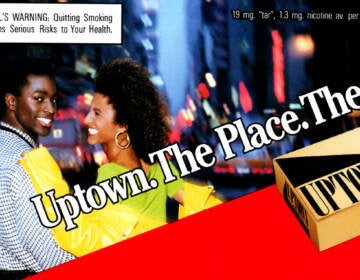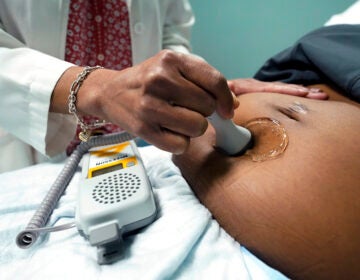Rutgers study: HPV-related throat cancers are on the rise, and it’s Black and Hispanic men who are more likely to die from the disease
While white men are disproportionately affected by HPV-related throat cancer, Black and Hispanic men are dying from the disease at higher rates.

In this Friday, June 15, 2012 photo, people walk by the Rutgers University School of Medicine. (AP Photo/Mel Evans)
Black and Hispanic men are dying at higher rates than white men from throat cancer caused by the human papillomavirus (HPV), a new Rutgers University study finds, but researchers can’t pinpoint the cause.
Notably, despite lower mortality rates among non-Hispanic white men, the researchers found that throat cancer disproportionately affects this group. Late-stage diagnosis increased by over 50% among white men from 2005 to 2016, while cases among minority populations have remained stable.
The Rutgers study, which was published recently in the Annals of Cancer Epidemiology, analyzed data from the North American Association of Central Cancer Registries on 162,183 men diagnosed with HPV-associated cancers between 2005 to 2016.
The researchers found that Black and Hispanic males had a shorter survival rate of roughly 30 months. Black men only had a 60% survival rate compared to 70% for other groups. The stage of diagnosis did not matter.
“What we found is that even though Black and Hispanic males don’t have a later-stage diagnosis, they’re having the higher death rates,” said Dr. Jeanne Ferrante, the study’s senior author and a professor in the Department of Family Medicine and Community Health at Rutgers Robert Wood Johnson Medical School. “And interestingly, we found that the higher death rates were younger, Black males less than 55 years old and only in the Northeast region of the United States.”
Last year in the U.S., more than 7,000 men died from cancers of the mouth and throat, and an estimated 38,800 men were diagnosed with the disease. The disease is more than twice as common in men as in women.
While throat cancer was previously linked to tobacco and alcohol use, it is now HPV – the most common sexually transmitted disease – that is thought to cause 70% of oropharyngeal cancers in the United States, according to the U.S. Centers for Disease Control and Prevention. The number of new male HPV-related throat cancer now exceeds cases of HPV-related cervical cancer in the U.S., according to the Rutgers researchers.
Ferrante said that one difficulty with diagnosing patients early is that HPV-related throat cancer may not be initially detectable.
“I think clinicians need to be more aware of the common clinical presentations,” Farrente said. “With these HPV-associated throat cancers, they tend to be asymptomatic, so they don’t really cause pain.”
Symptoms can include difficulty swallowing, a sore throat, hoarseness, ear pain, and weight loss.
The reason for higher mortality rates in Black and Hispanic men remains a question, but Ferrante has one hypothesis.
“We think that particularly for young Black males it may be having higher rates of HIV,” she said
Other factors may include lower socioeconomic status, being referred to surgery less frequently, or receiving care at lower-quality hospitals.
“[The study’s findings] certainly aligns with research here,” said Dr. Cecelia Schmalbach, chair of the Department of Otolaryngology at Temple University’s Lewis Katz School of Medicine.
Dr. Schmalbach said that research is continuing to show that HPV patients are predominantly young. Most patients don’t have a smoking or drinking history, and they often present with bulky lymph nodes as opposed to large tumors in the back of their throat.
She said that it’s important to recognize that HPV is a “ubiquitous” virus throughout the country and the world. She also said that medical providers gaining the trust of people of color can fix mortality-rate disparities.
“I think there’s a lot of understandable medical mistrust, especially among our Hispanic and Black community,” Schmalbach said. “I see it as the onus is on the part of the physician and the health care team to try and break down those barriers and ensure that we are always offering all treatment.”
In 2020, the Food and Drug Administration approved the use of Gardasil 9, the HPV vaccine, to prevent cancers of the head and neck. The vaccine is currently recommended for males and females ages 9 to 45 years old.
Support for WHYY’s coverage of health equity issues comes from the Commonwealth Fund.
WHYY is your source for fact-based, in-depth journalism and information. As a nonprofit organization, we rely on financial support from readers like you. Please give today.








